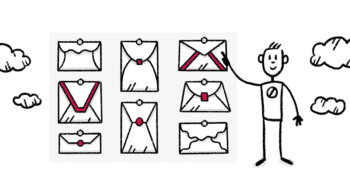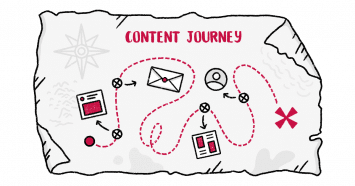The 10 SaaS Metrics you should obsess about

Choosing which metrics matter to your business can be challenging in the SaaS industry.
Should you care about MRR? What’s the deal with net new ARR? More importantly, is traffic really that unimportant?
Today, we’ll explore the 10 SaaS metrics that matter most and how you can improve them.
SaaS Metrics for Marketing
Marketing is an investment to drive more sales, grow a customer base, and scale a business. Here are two vital SaaS marketing metrics that show if your marketing efforts translate to business results.
1. Customer acquisition cost
Customer acquisition cost (CAC) is the cost of obtaining a customer. It’s often measured alongside the payback period, the time taken for a company to recover the cost of acquisition.
How to calculate this SaaS metric:
Total marketing and sales expenses / number of new customers
Why measure it:
A company’s bottom line suffers if it overspends on acquiring new customers, especially if they end up churning.
This metric can help you allocate your marketing budget accordingly and ensure that you’re making an ROI while growing your customer base.
How to improve it:
The longer customers stick around with your product, the more revenue you earn.
Wordable, a SaaS tool that publishes Google Docs to WordPress in a click, gives users all features during the free trial period.
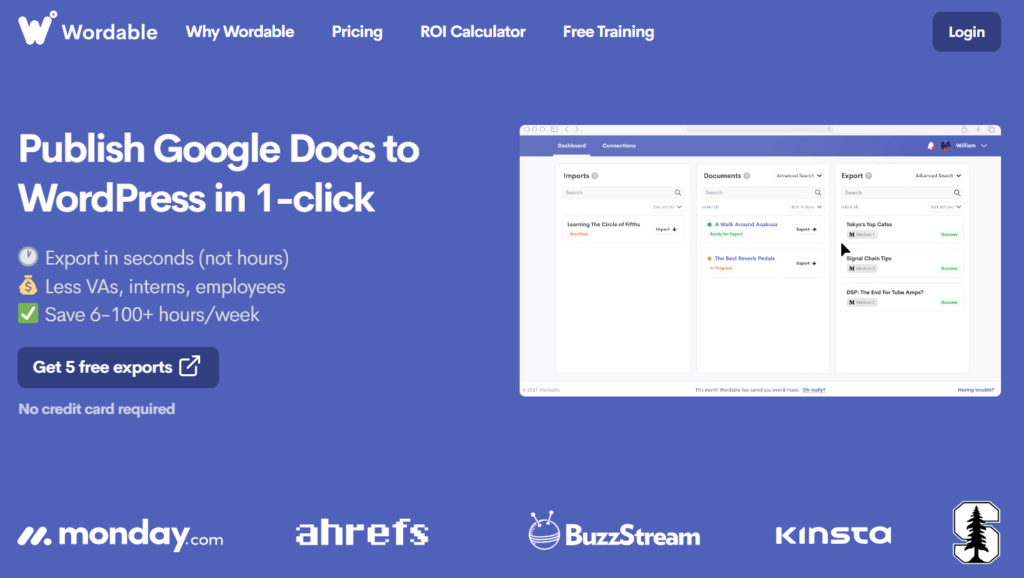
It’s a powerful play, according to Jeremy Moser, the co-owner of Wordable, as it appeals to loss aversion psychology.
“Users rather not lose the great features they’re already using than gain new ones from an upgrade.”
Eventually, conversions (from free trials to paid upgrades) improved, resulting in a significant reduction in CAC.
Customer education also improves CAC by a mile, according to Gauri Manglik, CEO and co-founder of Instrumentl.
The platform for non-profits and grant writers has been running free weekly educational workshops for the past 18 months.

Source: Instrumentl
The startup’s value-packed workshops created a flywheel.
Over time, it develops brand trust and customer loyalty, scaling its marketing and sales efforts and converting prospects into customers.
2. Revenue per channel
Revenue per channel is a bottom-of-the-funnel metric that tracks the sources that convert prospective customers in the buyer’s journey.
How to calculate this SaaS metric: Integrate all customer data in a marketing attribution software
Why measure it:
Because you should do more of what works and disinvest from what’s not working.
Revenues are the core of a Revenue marketing approach which I strongly recommend to every SaaS business.
That way, you can scale your best-performing sources (touchpoints, teams, or tactics) and increase ROI in the long term.
How to improve it:
The secret to successful revenue attribution lies in connecting all customer data in one place.
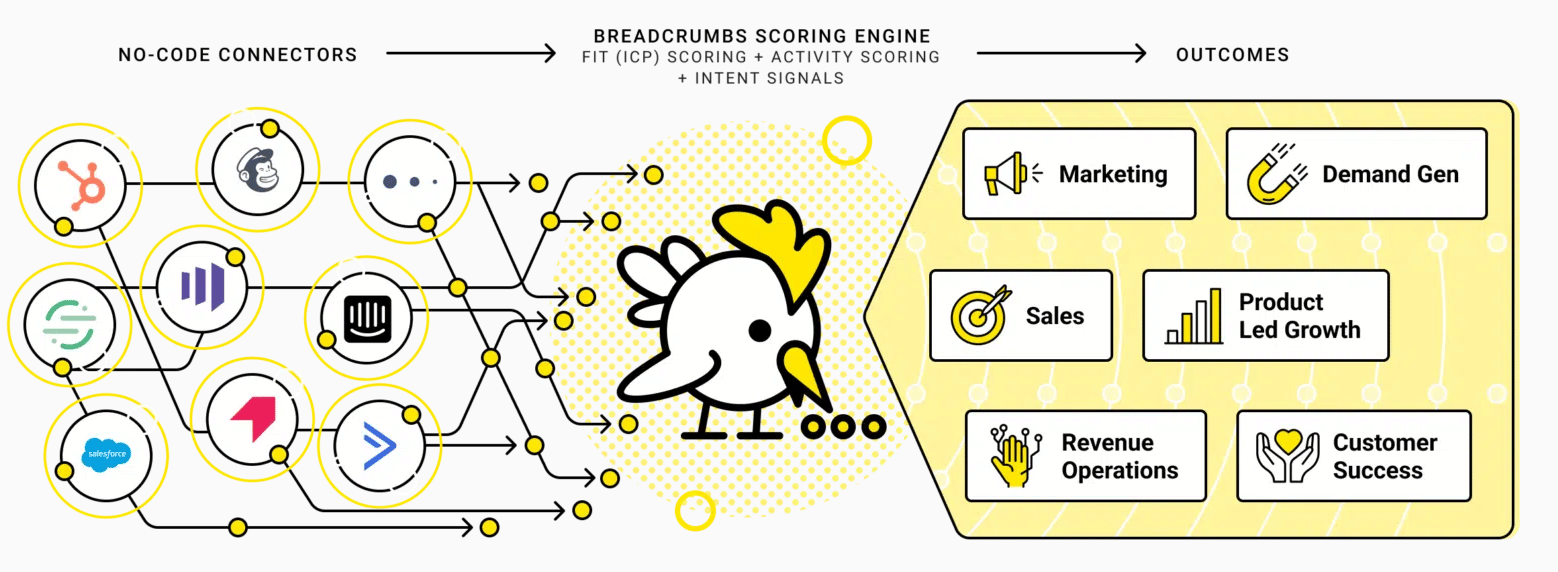
If you’re using only a CRM tool to engage with buyers, you probably struggle to identify sales-ready leads at the right time.
(Case in point: HubSpot’s lead scoring tool is extremely limited and doesn’t allow any fine-tuning on recency and frequency)
To take both the lead’s recency and frequency activity into account, integrate your CRM system with a contact scoring platform like Breadcrumbs. This helps you create a scoring model with more accurate data and context in each customer’s journey.
Connecting all dots from different tools into a single platform helps you understand what goes on in the buyer’s journey, even outside the CRM system.
SaaS Metrics for Revenue
Revenue is the north star of all organizations. Here are eight SaaS metrics to ensure that you’re heading in the right direction across your departments.
3. Net new monthly recurring revenue
Net new monthly recurring revenue (MRR) refers to the monthly revenue after you account for new customers, expansion, contraction, and cancellations.
How to calculate this SaaS metric:
New MRR from new customers + new MRR from upgrades – lost MRR from churn – lost MRR from downgrades
Why measure it:
Unlike MRR, net new MRR looks at the three major customer segments (new, existing, lost). This multi-layered metric helps you uncover a startup’s specific growth (and decay) drivers.
How to improve it:
Align all revenue-focused teams.
Marketers could sit in sales conversations to better understand the talking points. Customer support could share top concerns with product. Sales could share with marketing the deals that took the shortest time to close.
The net new MRR metric should be front and center. Motivate these revenue-driven teams to collaborate (not compete) towards this common goal.
Consider this unorthodox approach from ConvertKit. The email marketing startup shares its revenue, among other high-impact metrics, on a public page to keep everyone accountable.

Source: ConvertKit
Also watch out for high churn and downgrades, as both metrics could create an adverse impact on your net new MRR.
4. Net new annual recurring revenue
Net new annual recurring revenue (ARR) refers to annual revenue that looks at your new customers, expansion, contraction, and cancellations.
How to calculate this SaaS metric:
New ARR from new customers + new ARR from upgrades – lost ARR from churn – lost ARR from downgrades
Why measure it:
This metric is one of the leading indicators of future ARR growth. A healthy net new ARR indicates go-to-market maturity and product-market fit, both essential factors for investors.
How to improve it:
Similarly, focus on aligning every revenue-focused department.
Marketing, sales, customer support, and product should collaborate to break down silos, streamline information flow, and create a better customer experience.
5. Expansion monthly recurring revenue
Expansion monthly recurring revenue (MRR) is the additional recurring revenue from existing customers through cross sells, upsells, add-ons, and reactivation.
How to calculate this SaaS metric:
(Total expansion MRR at the end of the month – total expansion MRR at the beginning of the month) / total expansion MRR at the beginning of the month x 100%
Why measure it:
Expansion revenue is the missing key in net growth (fact: cross-selling alone increases profit by 30%).
Review your expansion MRR alongside the churn rate to gauge the health of your business.
How to improve it:
Intensive customer research comes into play here.
Find out the specific features your best customers will pay for and “lock” them into higher pricing tiers.
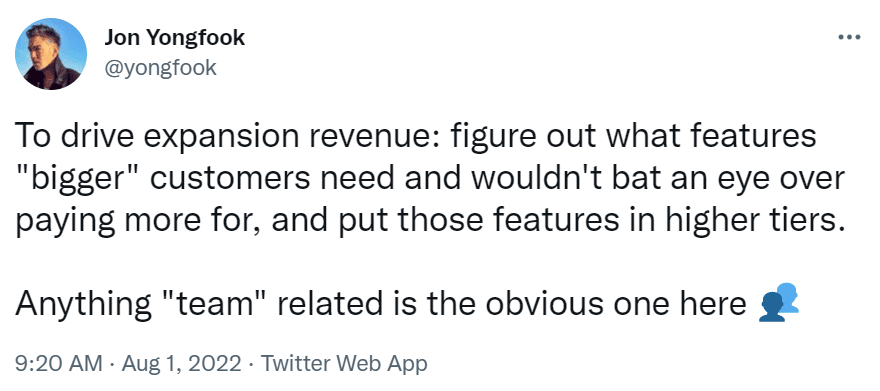
Source: Twitter
When Bannerbear implemented this strategy, it increased its expansion MRR by $2,848.
6. Expansion annual recurring revenue
Expansion annual recurring revenue (ARR) is the additional recurring revenue from existing customers you can expect every year.
How to calculate this SaaS metric:
(Total expansion ARR at the end of the year – total expansion ARR at the beginning of the year) / total expansion ARR at the beginning of the month x 100%
Why measure it:
Healthy expansion ARR signals growth.
Watch out if you see a drop in this metric. The customer success team may be struggling to identify cross- and upsell opportunities with customers.
How to improve it:
Increasing expansion ARR requires a similar approach to expansion MRR.
Once you’ve identified the features customers don’t mind paying more for, input them as a “signal” in the cross- or upsell scoring model (e.g., customers who invite over five users).
Tip: you can do this easily by integrating your product analytics suite with a contact scoring tool like Breadcrumbs. Whenever customers hit this predetermined criteria, Breadcrumbs will notify you of the cross- or upsell opportunity.
7. Logo churn
Logo churn, also known as customer churn, is the percentage of customers who failed to renew their subscription plan during a period.
How to calculate this SaaS metric:
(Lost customers / total customers at the start of a period) x 100
Why measure it:
The fewer customers, the smaller the profits.
Churn is less critical in the early days of business, but it can crush you in the long term.
In the first month of business, a 5% churn rate for 100 customers isn’t that big a deal. In contrast, a 5% churn rate of 100,000 customers would mean a loss of 5,000 customers.
How to improve it:
Once again, use a contact scoring tool like Breadcrumbs to catch customers before they leave.
In the scoring model, input the negative signals that show at-risk behavior (e.g., didn’t login in the past week, reads FAQ page on account downgrade) and set it live.

[Screenshot]
Each time a customer shows an at-risk behavior, the score gets deducted. Breadcrumbs will send all scoring information back to your CRM system, notifying you of these churning customers.
This lets you detect them with zero error and intervene at the right time.
8. Revenue churn
Revenue churn is the percentage of monthly recurring revenue lost due to account downgrades, cancellations, or failed charges over a period. This SaaS metric is often measured with logo churn to evaluate the overall customer health.
How to calculate this SaaS metric:
(MRR lost to downgrades, cancellations or failed charges in the last 30 days / MRR 30 days ago) x 100
Why measure it:
The lower the revenue, the lesser the returns. Keep a close eye on this metric!
How to improve it:
One common reason behind revenue churn is the lack of customer perceived value.
When customers fail to experience the value of a product, they will not stick around long.
Start creating product-led content to teach customers how to make the most of your product, especially if it involves a moderate to steep learning curve.
Note how Postmark weaves in its product naturally in an article on emails landing in spam folders. The startup outlines the top reasons emails are marked as spam and strategically positions its email delivery service as a solution.

Source: Postmark
Insufficient product guidance leads to confusion.
But when you educate customers that your product solves their problem, you have a much higher chance of convincing them to stick around with your product.
9. Burn rate
Burn rate is the amount of money spent every month before a business generates positive cash flow.
How to calculate this SaaS metric:
Total cash in beginning of the month – total cash at end of month
Why measure it:
Burn rate is one of the most important metrics in early stage startups.
Not only does it impact an investment round, it also helps you monitor your expenses and operational costs. Startups with an alarming burn rate might decide to delay promotions and hiring, for instance.
Measure your cash runway (formula: cash balance / net burn rate) to determine the number of months your startup has before it runs out of money.
How to improve it:
This is straightforward.
Start reducing expenses and raising revenue.
For the latter, opt for annual subscriptions. These yearly plans improve cash flow, secure upfront revenue, improve churn, and even earn back customer acquisition costs.
Make your pricing page stand out by emphasizing the benefits of your annual plans.
10. Customer lifetime value
Customer lifetime value (LTV or CLTV) is the total revenue a company can reasonably expect from a customer over the course of their entire relationship.
How to calculate this SaaS metric:
(Average order value + purchase frequency + average customer lifetime) x profit margin
Why measure it:
Follow where the money is.
CLTV identifies the specific segments of your most profitable customers today. Plus, it helps you decide how much you should spend on acquiring customers and retaining them.
Tip: use Breadcrumbs Reveal to highlight the attributes and actions that bring you revenue.
How to improve it:
There are various ways to increase CLTV, depending on where you’re leaking revenue.
For example, a startup that focuses only on acquisition and expansion revenue will likely see a lot of involuntary churn (churn caused by failed payments).
If you’re in this boat, consider Squarespace’s approach: set up a dunning email sequence to remind customers about their billing failure.
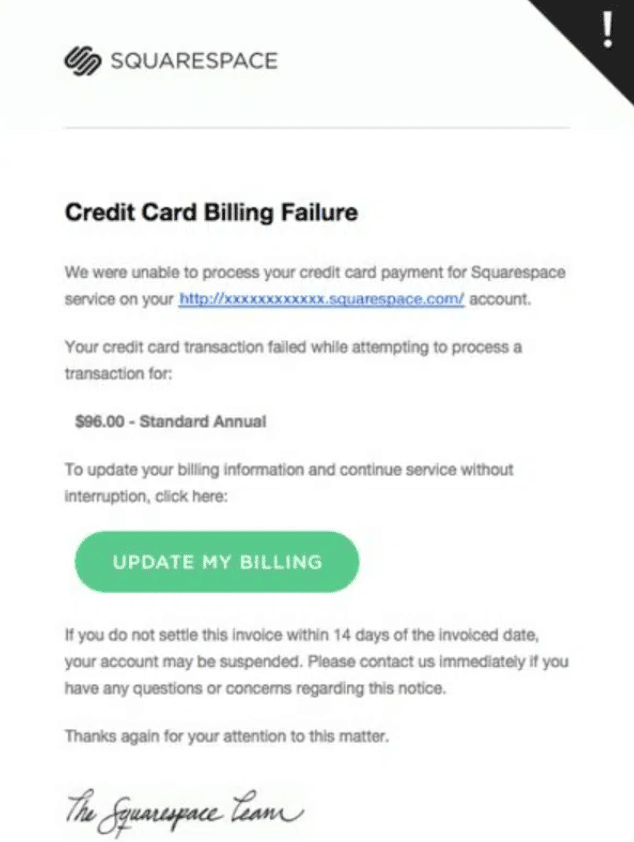
Source: Pinterest
Other ways to increase CLTV include:
- Cross- and upselling: A contact scoring tool like Breadcrumbs can help identify customers with cross- and upsell potential.
- Optimizing pricing model: Pricing models are not a one-off task. Stop leaving money on the table! Wordable implements a usage-based pricing model and gives users the option to adjust their plan freely. Instead of canceling during a slow month (and rarely returning), they can tweak their plan as and when they like to fit their ever-changing needs.
- Gather customer feedback: Customer-centric companies earn more revenue as they add meaningful incremental value consistently. When Instrumentl began offering the integrations customers requested, the sales team could pitch higher-tier plans without a hitch. Wordable builds custom features for enterprise customers. Its four-way combo (flexible pricing + usage-based model + onboarding experience + custom services) led to a 36.6% increase in CLTV in the last three months.
SaaS Metrics You Can Ignore
Vanity metrics are low-impact metrics without context and/or don’t translate to business results.
Unfortunately, it’s not that straightforward to determine which metrics you should ignore and which you shouldn’t.
You can probably ignore the high traffic your lead generation ads generated if it doesn’t end up converting leads to paying customers (OR if they do convert but have a low CLTV).
Similarly, a startup with high ARR may not always be a good thing as it doesn’t consider its churned customers (hence the reason you should track net new ARR).
When AdEspresso invested all its budgets in Facebook Ads in the Brazilian market, it acquired users at a cheap price and saw high conversions. But it also experienced extremely high churn and low average CLTV.
Here’s Max recounting the experience:
“Since Facebook was an effective channel for Brazilian marketers, a solution like AdEspresso was a no-brainer. However, our plan at $49/month was extremely expensive from what they were used to. They wanted bigger improvements in their campaigns to justify the cost of our tool.”
Ultimately, your metrics will depend on context.
As a smart user on Reddit once said:
All metrics matter and have a purpose if you know what you’re looking for.
Final Thoughts
Context should determine your metrics.
The 10 SaaS metrics listed above are a good starting point for tracking growth and assessing business health.
Start measuring them to paint an accurate picture of your startup today. Then add or remove based on your business goals.
